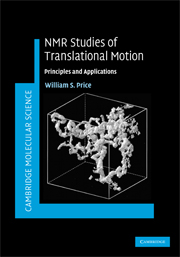Book contents
- Frontmatter
- Contents
- Preface
- Acknowledgements
- Abbreviations
- 1 Diffusion and its measurement
- 2 Theory of NMR diffusion and flow measurements
- 3 PGSE measurements in simple porous systems
- 4 PGSE measurements in complex and exchanging systems
- 5 PGSE hardware
- 6 Setup and analysis of PGSE experiments
- 7 PGSE hardware and sample problems
- 8 Specialised PGSE and related techniques
- 9 NMR imaging studies of translational motion
- 10 B1 gradient methods
- 11 Applications
- Appendix
- Index
- References
6 - Setup and analysis of PGSE experiments
Published online by Cambridge University Press: 06 August 2010
- Frontmatter
- Contents
- Preface
- Acknowledgements
- Abbreviations
- 1 Diffusion and its measurement
- 2 Theory of NMR diffusion and flow measurements
- 3 PGSE measurements in simple porous systems
- 4 PGSE measurements in complex and exchanging systems
- 5 PGSE hardware
- 6 Setup and analysis of PGSE experiments
- 7 PGSE hardware and sample problems
- 8 Specialised PGSE and related techniques
- 9 NMR imaging studies of translational motion
- 10 B1 gradient methods
- 11 Applications
- Appendix
- Index
- References
Summary
Introduction
This chapter is concerned with the practical issues and key considerations involved in setting up PGSE experiments and the subsequent data analysis. Selection of PGSE parameters is discussed in Section 6.2 and sample preparation is discussed in Section 6.3. The various methods of gradient calibration are considered in Section 6.4. Finally, PGSE data analysis and display are considered in Section 6.5. Under favourable conditions it is possible to measure diffusion coefficients with greater than 99% accuracy. Indeed simple PGSE experiments have been shown to be reasonably robust with respect to experimental parameters (e.g., rf pulse flip angle). It cannot be overemphasised that the overall accuracy of a diffusion measurement is intimately connected to the accuracy of the gradient calibration. It is too easy to confuse the apparent precision of a diffusion measurement obtained from analysing the PGSE data with the true overall accuracy. For example, the PGSE data obtained from an experiment may be highly single exponential, but the gradient calibration or temperature control may have been inaccurate such that the analysis of the PGSE data leads to a highly precise but unfortunately a highly inaccurate diffusion coefficient.
Irrespective of the aim of the PGSE experiment, the analysis is always simplified by starting with a distortion-free data set with good signal-to-noise and, especially when the system has multiple components, good resolution.
Information
- Type
- Chapter
- Information
- NMR Studies of Translational MotionPrinciples and Applications, pp. 198 - 220Publisher: Cambridge University PressPrint publication year: 2009
